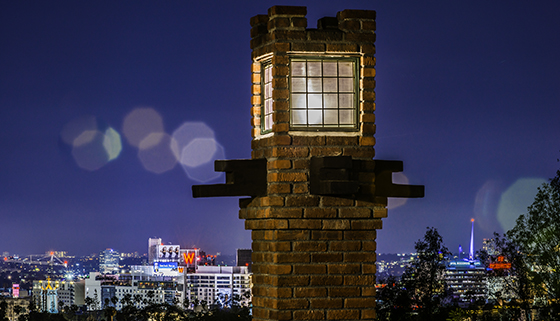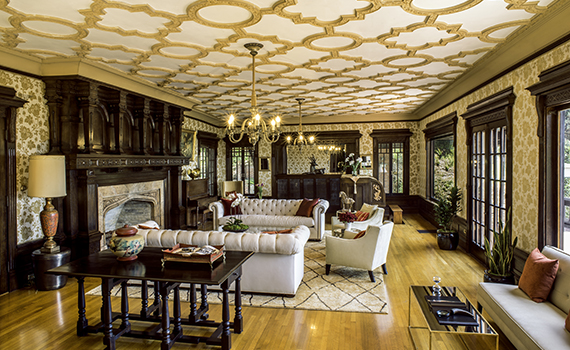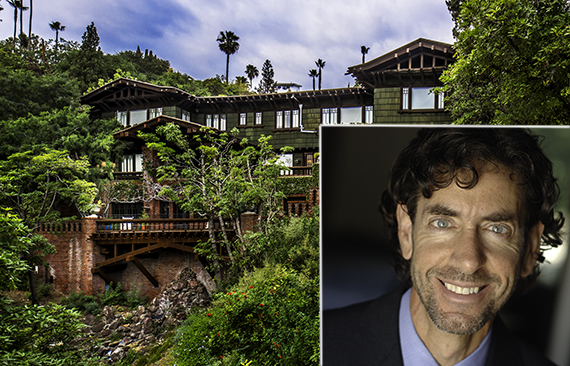The largest craftsman house in the United States is about to hit the market for just shy of $10 million. The sale is the opposite of a quick flip. It was the all-consuming obsession of its owner, who spent almost 30 years meticulously restoring it.
In 1987, a two-line classified ad led Leonard Fenton to the end of a private drive in a gated community. The notice, “1913 Hollywood mansion,” was either coy or desperate and Fenton — whose self-started advertising firm would later sell to Microsoft— was willing to find out.
What he discovered was an eight-bedroom, seven-bath behemoth that seemed to have trudged up a hillside, sat down and settled in for a century of meditation. Its sun-scorched wooden shakes and beam ends were nearly camouflaged by overgrown vegetation.
“I saw this big, brown, looming wooden thing and at first I was really put off,” Fenton told The Real Deal. “I was in my early 20s and I didn’t know (the architecture firms) Greene and Greene or Gamble House. Then they opened this big, five-foot-wide front door with Viking nail heads on the outside and I walked through.
“I looked left and I looked right, and I decided to buy the house.”

The lighthouse at Artemesia on 5771 Valley Oak Drive in Los Feliz
Fenton’s new home, dubbed, Artemesia, turned out to be a rare historical find. It is the largest craftsman residence built in the U.S. and happens to be located in one of the Hollywood Hills most secluded forested neighborhoods, where it overlooks a vista that includes the W Hotel, Capitol Records, and at a distance, the ocean.
The 13,290-square-foot home at 5771 Valley Oak Drive in Los Feliz Oaks was built in 1913 by Frederick Engstrum, a construction company executive who commissioned Commonwealth Home Builders to erect the house. Frank Brown, an architect at the construction firm, is credited with Artemesia’s design. During the build, costs soared to $10,000, a luxuriant amount in 1913, when most homes were built for two-tenths the price.
Fenton will soon relist the house for $10 million. It was previously listed for several months at the same price range in late 2014 and early 2015. That was after a price chop. In July 2012, it was listed for an ambitious price just shy of $12 million.
“When I purchased it, I didn’t know much about the history of the home, but I knew the proportions were gorgeous,” Fenton said. “I could see the beauty. I could tell this was a castle that needed polishing. I tend to the be kind of person that likes to do things properly.”
Fenton set about researching the home and its style, as well as the techniques necessary to achieve a museum-quality restoration. And although Fenton had previously worked on a few home restoration projects while funding his aspirations as a classical musician (he trained in France and then earned multiple graduate degrees at the Royal Academy of Music in London), Artemesia presented itself as both overwhelming and promising.
“It had decades of deferred maintenance. The roof had problems. Everything had problems,” Fenton said. “What was good was that no remodeling had occurred. Every window catch, every door handle was exactly identical to 1913, when it was installed.”
This true-to-period vibe includes Artemesia’s concert organ, the second largest and most complex organ ever built in a U.S. residence. Valued at an estimated $1.1 million, the Murray Harris player organ has pipes and chimes numbering into the hundreds and is designed to fill the three-story home with sound. “The house is almost built around the organ,” Fenton said.

A salon in the Artemesia house at 5771 Valley Oak Drive in Los Feliz
He ventured that Engstrum, who was also responsible for developing the Rosslyn Hotel in Downtown Los Angeles, was showing off his degree of sophistication when he had the house built, Fenton says.
Artemesia includes a dining room that seats 40 people, a 2,000-square-foot ballroom that may actually have served as a gymnasium and a sleeping porch to the rear of the home with five Murphy beds concealed by Redwood panels.
It has six fireplaces and a rainwater collection system that once supplied bathroom showers and then sent recycled gray water to the garden.
In addition to a meticulous interior and exterior remodel that, on at least one occasion, included the removal of thousands of individual tiles, Fenton also reportedly spent nearly a quarter of a million dollars on a redwood terrace near an arroyo on the property and invested in its landscaping and grounds.
As he restored the home’s former luster, Fenton brought it into the modern age. Artemesia is now hardwired with computer, surveillance and data cables, as well as fiber optic cable running to 33 different locations in the property. There are other behind-the-scenes upgrades, including new heating and cooling systems.
“When I bought this property, I was so young. I thought, ‘Oh yeah, I can do this,’” Fenton says. “Artemesia taught me the patience to take a careful, methodical and researched approach. That’s hard to do. We’re usually encouraged to take immediate action, but here I was rewarded by taking a slow and careful approach. I have a great respect for history and for the skills of artisans and architects and craftsman of the past. We have this arrogance that we know everything better than everyone before. I no longer have that view.”
